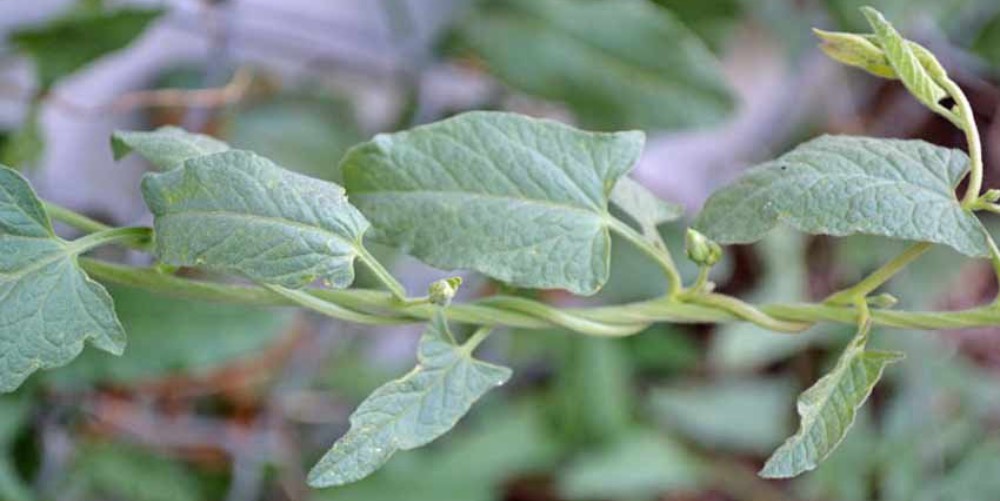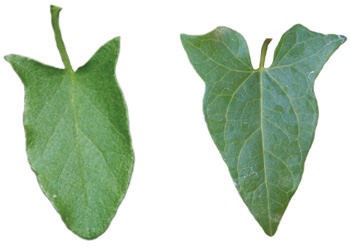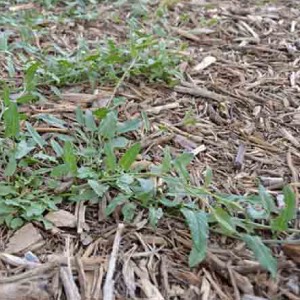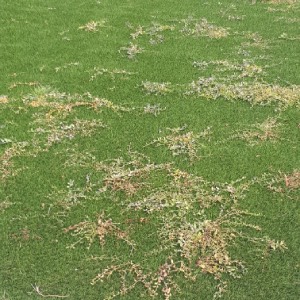- Duralawn
- Artificial Grass Installation
- Bindweed
Bindweed
Bindweed is often found invading gardens, lawns, orchards and various other food crops in Canada and around the world. The two most common forms; field and hedge have very similar properties that include being nearly impossible to eradicate and growing everywhere you don't want it to grow, including artificial grass. In this article we are going to look at how to identify, kill and prevent this elusive weed.

A troubling trend is bindweed or bindvine growing through artificial grass that wasn't installed properly. The culprits are often an inadequate sub layer or a cheap landscape fabric was used instead of a quality commercial grade weed barrier fabric. A proper artificial grass installation is important if you are considering replacing your natural lawn with artificial grass especially if you know or suspect bindweed is present.
What is Bindweed?
Bindweed as the name suggests is a weed that binds to, and often takes over other plant materials and just about anything it comes into contact with. It's been known to completely suffocate gardens, crops and residential lawns in all parts of the globe in many different climates and soil types. The most common form is known as Convolvulus arvensis field bindweed and it has some distinct characteristics that help with identification.

The bindweed leaves are arrowhead shaped ranging from 2-5 cm in length. The flowers that bloom in early and mid summer are trumpet-shaped and commonly found in white, pale pink or dark pink with stripes. The seeds within the light brown fruit are often eaten by birds and can remain viable for up to 20 years in soil.
The images to the right shows the leaf structure of field bindweed (left) and hedge bindweed (right). Bindweed identification can be difficult especially since there are dozens of varieties with similar characteristics. It's worth noting that bindweed has several common names that have been used and made obsolete over the years that include; wild morning glory, European bindweed, lesser bindweed and creeping jenny.
What makes bindweed one of the most noxious weeds in the world is that it's incredibly resilient with an elaborate root structure that has been reported to be as deep as 20 feet. The root structure that can grow from seeds as old as 20 years includes shoots that grow horizontally mostly in the upper 1 to 2 feet of soil. This means they can traverse unnoticed for an estimated 10 feet per season until they shoot upwards towards a light source.
How to Kill Bindweed
How to kill bindweed. It is possible to kill bindweed but it isn't easy especially if it already has a foothold on your garden, lawn or yard in the form of a self-spreading ground cover or a towering vine. The best weed killer for bindweed will contain either glyphosate sold under the brand name Ortho Killex or quinoline carboxylic acid each sold under commercial brand names of Quinclorac and Drive XLR8. These products work but they do require diligence on the users part which includes a weekly or bi-weekly routine.
Ortho Killex Lawn Weed Killer ConcentrateIf you click on this link and make a purchase, we may earn a commission. |
The best way to get rid of bindweed is to tackle the weed consistently for as long as it continues to grow. The goal is to spray or otherwise coat the leaves with herbicide as efficiently as possible. This can be achieved by placing a stake, bamboo cane or something similar for the weed to attach itself, exposing the leaves for easy herbicide application. This also allows isolation of the weed which is important if you don't want to kill nearby vegetation.
Another approach is to pull out the patches of bindweed and disturb the soil where the root is located. This can be done with a shovel or pitchfork, keeping in mind that the roots can grow several feet underground so try to get as deep as possible. The roots and weed should be disposed in the garbage and not placed in a compost pile because of the risk of spreading.
Natural Bindweed Control
Similar to using herbicide chemicals to kill bindweed, the natural or organic approach to controlling the invasive weed will take persistence and up to 5 years of constant attention. The root system will need to be dug up or cultivated as deep as possible, keeping in mind that even a small fragment of the root left in the soil can regenerate a new shoot in as little as a couple weeks. Just like you will need to reapply the chemical glyphosate herbicide spray or gel, the natural approach of manual removal of bindweed will take dedication and patience.
A method that has been used with some reported success involves applying a mixture of vinegar (1/2 gallon), salt (1/2 cup) and dishwashing liquid (2 tbsp) to the leaves and plant repeatedly. The complete eradication of the weed shouldn't be expected but it may be effective in controlling and preventing the weed from growing in certain areas of your yard or garden. This is a more natural and gentler approach to controlling bindweed.
How to Prevent Bindweed
The best way to prevent bindweed is to keep it out of yard to begin with. This can be achieved by ensuring that soil, compost, mulch or any foreign organic material introduced to your yard isn't contaminated. The use of contaminated soil is the easiest way for bindweed to spread and can easily be avoided by purchasing soil from a reputable source.

If bindweed is already present in your yard or it's made it's way to your garden from your neighbours yard, there are a few ways you can prevent the spread. As you've probably learned it's very hard to kill bindweed but you can keep it under control and out of areas you don't want it like a lawn or garden.
A quality commercial weed barrier fabric is one of the best ways you can stifle the growth of bindweed. While it won't kill bindweed it will do a great job of preventing growth wherever the weed barrier is used. The black fabric will block sunlight form reaching the soil underneath and act as a barrier to growth whether it's under mulch, ornamental rock or artificial grass.
There are a few herbicides that are effective at killing and controlling bindweed with careful and diligent application. We don't recommend herbicides as a first option because of the toxic nature of chemicals but if used properly they can be very effective. The safety of herbicides is essential and always follow manufacturers safety and usage guidelines before using.
Unbalanced soil can be the culprit for many weeds including bindweed. It's common for soil to become naturally depleted of magnesium and potassium, and the simple act of adding these minerals back into the soil can do wonders for weeds and plant health. Adjusting the pH of soil can be done over time and is also a good idea to match the vegetation it is nourishing.
Bindweed in Artificial Grass
If you have the luxury of owning artificial grass you likely enjoy the ultra low maintenance that comes with it. If you are experiencing weeds growing through your artificial grass it's not only annoying, it defeats the purpose of choosing artificial in the first place. The reality is that any artificial grass installed properly should never experience weeds beyond the odd spot weed that can develop from a random blown in seed landing on the surface of the grass.

What is the best way to control weeds growing in artificial grass? If you are seeing weeds in your artificial grass, namely bindweed, it's very likely that the sub base was not prepared adequately. It's imperative that organics are removed from the soil and replaced with a 4" to 6" layer of crusher chips or road base. This layer needs to be packed and soaked so it creates an almost concrete-like layer that not only prevents weeds from punching through but also creates a sturdy base for the artificial grass. A properly prepared base will keep weeds at bay and increase the durability of the grass over it's lifetime.
In order to eliminate weeds already growing in artificial grass we recommend consulting a professional artificial grass installer to get to the root of the problem. An expert in the industry will determine what's causing the problem and how to remedy it. It may need to be rolled back and a weed barrier placed underneath the turf or it may require a complete restructuring of the sub layer.
If you have any questions about removing bindweed from artificial grass in Kelowna and surrounding Okanagan Valley be sure to contact us. We take pride in being a reliable source for information, advice and professionalism in the Canadian artificial grass industry.
Disclaimer
Please use all appropriate and proper safety precautions when attempting projects on this website. All projects are attempted at the reader's own risk.
Duralawn® participates in the Amazon Services LLC Associates Program, as an Amazon Associate we may earn a commission from qualifying purchases.
Duralawn® artificial grass installations, products and service in Kelowna, Vernon, Penticton, etc since 2018.

